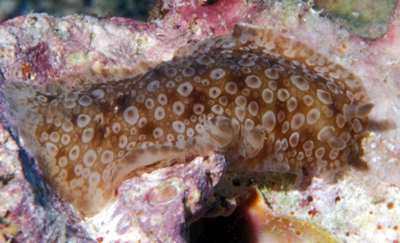
Dendrodoris albopurpura
Burn, 1957
Order: NUDIBRANCHIA
Suborder: DORIDINA
Family: Dendrodorididae
DISTRIBUTION
Wide Western Pacific distribution and perhaps Indian Ocean. Found throughout Australia.
PHOTO
Koumac, New Caledonia, October 1993, 90mm long alive. PHOTO: Bill Rudman.
There is considerable confusion in the literature between this species and the species I am tentatively giving the name Dendrodoris elongata, although there are earlier names for both, which I am in the process of clarifying. Both have the ability to extend their body 'leech-like' as described from Dolabrifera dolabrifera, and in having the gills at the extreme posterior end of the body. This species differs from 'D. elongata' in having conical warts all over the dorsum.
Reference:
• Burn, R. (1957) On some opisthobranchia from Victoria. Journal of the Malacological Society of Australia, 1(1): 11-29.
Note added Feb 22, 2000: This page was previously titled Dendrodoris albobrunnea Allan, 1933. See message below explaining name change.
Authorship detailsRudman, W.B., 1999 (April 18) Dendrodoris albopurpura Burn, 1957. [In] Sea Slug Forum. Australian Museum, Sydney. Available from http://www.seaslugforum.net/find/dendalbo
Related messages
Dendrodoris albopurpura from Hawaii
December 6, 2003
From: Tina Owens

Note: this is part of Tina Owen's message about D. carbunculosa. I have copied this section concerning D. albopurpura so there is a cross reference.
Dear Dr. Rudman:
I live and dive on the Kona Coast of the Big Island of Hawaii. ...... last Sunday [November 2003] I found this creature [lower photo] which has really confused me. It was about 750mm long, found in 7m of water at a completely different dive site.
My friends thought it was a juvenile D. tuberculosa, since several of them have been found recently at that dive site However, I thought back to a message that D. Lundholm sent you (June 6, 2003) about a nudi that Sharon Williams found on the Kona Coast of Hawaii. You identified that animal as a juvenile D. carbunculosa. I think my mystery nudi could be a sub adult of that species because of the white spots with bumps on its back. The mantle edges seem to already be turning into the lumpy adult form.
The reason why I was confused is that, as far as I know, no one has ever found an adult D. carbunculosa in this area, yet S. Williams found a juvenile, and this may well be a juvenile, too. ....
Tina Owens
bob-tinaowens@hawaii.rr.com
Owens, T., 2003 (Dec 6) Dendrodoris albopurpura from Hawaii. [Message in] Sea Slug Forum. Australian Museum, Sydney. Available from http://www.seaslugforum.net/find/11624Dear Tina,
The animal in this photo is definitely Dendrodoris albopurpura which is definitely a new record for Hawaii. It is much more elongate than D. carbunculosa and the body is much softer, the mantle much thinner, and definitely not stiff and rigid to touch.
Best wishes
Bill Rudman
Dendrodoris albopurpura from Christmas Island
May 17, 2002
From: W.B. Rudman


Here are some photos of Dendrodoris albopurpura from John Hicks' Christmas Island, Indian Ocean collections.
PHOTOS: AM C130157, 70 mm long alive, 14 June 1981, Egeria Point, 10m, under rock, near black sponge, Christmas Is., Indian Ocean. Photo: John Hicks
Best wishes,
Bill Rudman
Dendrodoris albopurpura from South Australia
February 22, 2000
From: Stuart Hutchison


Dear Bill,
Here is Dendrodoris albopurpura - our first sighting at Edithburgh [South Australia] in 5 Years. Seen on Sunday just past (30 Jan 00). The animal was about three inches long [approx 75mm] and was found hiding under a piece of wood with two eggmasses in about 3m of water.
Regards,
Stuart Hutchison
hutchco@tpg.com.au
Hutchison, S., 2000 (Feb 22) Dendrodoris albopurpura from South Australia. [Message in] Sea Slug Forum. Australian Museum, Sydney. Available from http://www.seaslugforum.net/find/1825Dear Stuart,
Thanks for the photo and especially the egg mass. We can't be 100% sure that the eggs were produced by D. albopurpura unless the animal is caught in the act but it's a good start.
Your photo also gave me the opportunity to correct an error. I have previously called this animal D. albobrunnea Allan, 1933. However Allan specifically states that in that species the mantle is smooth with no tubercles so it can't be this animal. On the other hand Burn's description specifically mentions 'blister-like pustules capped with a purple spot.' Burn's name is usually written 'albopurpurea' but in the original description it is 'albopurpura'.
Best wishes,
Bill Rudman.
Dendrodoris albobrunnea from Kerama Islands
April 18, 1999
From: Rie Nakano

Dear Bill,
Here is another of Mr Atsushi Ono's images from Kerama Island, near Okinawa which you offered to identify for us.
Mr.Ono thinks it is Dendrodoris albopurpurea but Mr Cory Pittman suggested it is Dendrodoris sp.
Rie Nakano.
rie@street.ne.jp
Nakano, R., 1999 (Apr 18) Dendrodoris albobrunnea from Kerama Islands. [Message in] Sea Slug Forum. Australian Museum, Sydney. Available from http://www.seaslugforum.net/find/781Dear Rie,
It is definitely a species of Dendrodoris and is very similar to Dendrodoris elongata Baba in the way it elongates its body, and has its gills very far to the back of the body. The correct taxonomy of these two species is very confused. Willan & Coleman identify this species as Dendrodoris albobrunnea Allan 1933 but I am not sure they are correct.
Best wishes,
Bill Rudman.
